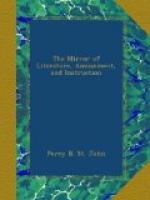[This work is, to our thinking, what it professes to be, an actual correspondence, and from the pen of a lady who, as her motto states—“writes of countries and their societies as she finds them, and as they strike her imagination.” There is much good sense in her letters, and less aristocratic affectation than might be expected. The subjects are of the most miscellaneous description. Her pen is what the small critics call eminently graphic: in short, the work is one of the pleasantest of the season. To be more explicit, it consists of letters written between June, 1814, and December, 1816; dated from South Lancing, (near Worthing), Rouen, Paris, and Brussels; and the writer’s domicile, Hampton Court. The most interesting portion of the work is the gossip it contains on the state of things in the French capital, on the return of Napoleon, in 1815, and in Brussels, before and after the battle of Waterloo. Nevertheless, as the whole is indiscribably discursive, so must be our quotations.]
Arundel Castle.—Arundel Castle did not gratify my expectations although the coup d’oeil, taking the structure en masse, is imposing, and it has an advantageous position on the banks of the river Arun. The Castle has undergone modern alterations in bad taste; the details are of that description of the ornamental gothic, which appear to me to throw severe criticism on the abilities of the architect; and, as a family residence, its interior is neither grand nor comfortable. From its commanding site and vicinity to the Roman villa, it was probably a Roman station previous to its becoming a Saxon residence. The walls and Norman gateway are fine. The massive keep, ponderous in stability, has the characteristic marks of the twelfth century, and is a noble ruin. It is called King Alfred’s Keep; and with what hallowed feelings of reverence must a locale ever be approached which bears the name of that illustrious monarch! The present occupants are an assemblage of German owls, of varied species; they look analagous with the venerable ruin.
The castle contains a few curious portraits of the illustrious race of Howard, which have an interest also from the distinguished parts that family have played in English history. There is one of Henry Howard, Earl of Surrey, so famous for his talents in state affairs, and for his bravery in the field. He is represented standing under a noble gateway. The picture is moreover valuable as a work of art.[6]
[6] Surrey’s accomplishments and political talents, and his bravery in the battle-field, cast additional splendour over the house of Howard; and his violent death, another stain on the tyranny of Henry VIII.
Some richly-wrought chalices[7] and censers, and other symbolic emblems of the Roman Catholic religion are there, but I imagine little prized by the present noble possessor; for at the age of twenty-seven, he




